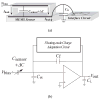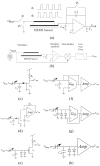A Charge-Based Low-Power High-SNR Capacitive Sensing Interface Circuit
- PMID: 18787650
- PMCID: PMC2533519
- DOI: 10.1109/TCSI.2008.918006
A Charge-Based Low-Power High-SNR Capacitive Sensing Interface Circuit
Abstract
This paper describes a low-power approach to capacitive sensing that achieves a high signal-to-noise ratio. The circuit is composed of a capacitive feedback charge amplifier and a charge adaptation circuit. Without the adaptation circuit, the charge amplifier only consumes 1 μW to achieve the audio band SNR of 69.34dB. An adaptation scheme using Fowler-Nordheim tunneling and channel hot electron injection mechanisms to stabilize the DC output voltage is demonstrated. This scheme provides a very low frequency pole at 0.2Hz. The measured noise spectrums show that this slow-time scale adaptation does not degrade the circuit performance. The DC path can also be provided by a large feedback resistance without causing extra power consumption. A charge amplifier with a MOS-bipolar pseudo-resistor feedback scheme is interfaced with a capacitive micromachined ultrasonic transducer to demonstrate the feasibility of this approach for ultrasound applications.
Figures














References
-
- Kucic M, Low A, Hasler P, Neff J. A programmable continuous-time floating-gate Fourier processor. IEEE Trans Circuit and system II. 2001 Jan;:90–99.
-
- Hasler P, Minch BA, Diorio C. An autozeroing floating-gate amplifier. IEEE Trans Circuit and system II. 2001 Jan;48(1):74–82.
-
- Ramirez-Angulo J, Lopez-Martin AJ, Carvajal RG, Chavero FM. Very low-voltage analog signal processing based on quasi-floating gate transistors. J SOLID-STATE CIRCUITS. 2004 June;39(3)
-
- Peng S-Y, Qureshi MS, Hasler PE, Hall NA, Degertekin FL. High signal-to-noise ratio capacitive sensing transducer. IEEE Proceedings of the International Symposium on Circuits and Systems. 2006 May;
-
- Peng S-Y, Qureshi MS, Basu A, Hasler PE, Degertekin FL. A floating-gate based low-power capacitive sensing interface circuit. IEEE Proceedings of the Custom Integrated Circuits Conference. 2006 Sep;
Grants and funding
LinkOut - more resources
Full Text Sources
Other Literature Sources
